

Fryeria marindica
(Yonow & Hayward, 1991)
Order: NUDIBRANCHIA
Suborder: DORIDINA
Family: Phyllidiidae
DISTRIBUTION
Known from coral reefs in the Indian Ocean from northern Western Australia to eastern Africa.
PHOTO
UPPER: 16 m depth, Phi Phi Island, southern Thailand, 27 Nov. 1989, dorsal view of 26 mm specimen specimen (Brunckhorst, 1993: Plate 5B);
LOWER: 9 m depth, Phi Phi Island, southern Thailand, 27 Nov. 1989, dorsal view of 25 mm specimen (Brunckhorst, 1993: Plate 5C).
Notes compiled from Brunckhorst, 1993:
F. marindica is predominately blue-grey in colour with two longitudinal black bands running the length of the mantle, one on each side of a single median blue ridge. The median ridge has a single row of yellow capped tubercles. There are also many black rays or lines, on either side of the mantle, running at right angles to the mantle edge. There are 20-23 lamellae on each of the yellow rhinophore clubs. The ventral surface of mantle and the foot are grey, as is the anal papilla.
Fryeria marindica appears to be closest to F. menindie which is found in the western Pacific Ocean. However, F. menindie is more oval in shape, possesses large, broad based tubercles which are gold capped and tall rhinotubercles. For specimens of similar size, F. menindie possesses fewer lamellae on each rhinophoral clavus, has three low, mid-dorsal ridges (F. marindica has one) and blue crescentic areas on the mantle margin. Ventrally, F. menindie is paler and it has an anterior indentation on the foot. Internally, the foregut of F. menindie is white whereas that of F. marindica is cream with a dark band.
This species has often been confused with Fryeria rueppelii Bergh, which is considered by Brunckhorst to be confined to the Red Sea. It is also likely to be mistaken for the widespread Phyllidia varicosa but in that species there are always three or five longitudinal ridges on the dorsum, and of course the anus opens in the dorsal midline.
Reference:
• Brunckhorst, D.J. (1993) The systematics and phylogeny of Phyllidiid Nudibranchs (Doridoidea). Records of the Australian Museum, Supplement 16: 1-107.
Rudman, W.B., 1999 (July 15) Fryeria marindica (Yonow & Hayward, 1991). [In] Sea Slug Forum. Australian Museum, Sydney. Available from http://www.seaslugforum.net/find/fryemari
Related messages
Fryeria marindica from eastern South Africa
January 18, 2007
From: Lior Harari
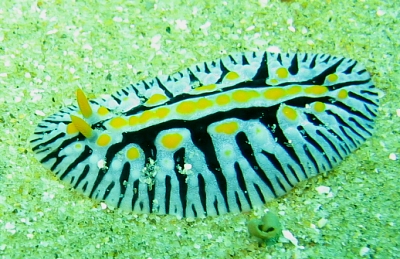
Dear Bill,
I have seen this one on a sandy patch not a few meters from the corals and the rocks. The dive was at the Ribbon Reef, Sodwana Bay
Locality: Sodwana Bay, 15-20 meters, South Africa, Indian Ocean, 13 December 2006, sandy patch. Photographer: Lior Harari.
I would like to know its name.
Thanks,
Lior
hararilior@yahoo.com
Harari, Lior, 2007 (Jan 18) Fryeria marindica from eastern South Africa. [Message in] Sea Slug Forum. Australian Museum, Sydney. Available from http://www.seaslugforum.net/find/19077
Dear Lior,
I am pretty sure this is Fryeria marindica
Best wishes,
Bill Rudman
Flatworm or Nudibranch from Phuket, Thailand
August 12, 2006
From: Mike Krampf
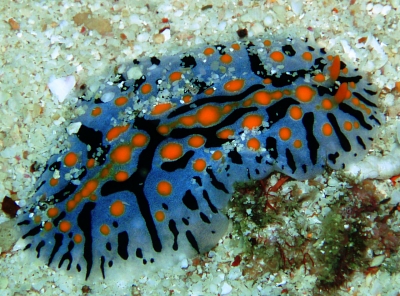
This looks like a Phyllidia sp but was very flat and I haven't been able to find it in any of my ID books. Is this one of those flatworms at mimic nudibranchs?
Locality: Racha Yai Island, 70 ft, Phuket, Thailand, Andaman Sea, 05 August 2006, Sand bottom. Length: 3 cm. Photographer: Mike Krampf.
Thanks,
Mike
mtkrampf@yahoo.com
Krampf, M., 2006 (Aug 12) Flatworm or Nudibranch from Phuket, Thailand. [Message in] Sea Slug Forum. Australian Museum, Sydney. Available from http://www.seaslugforum.net/find/17369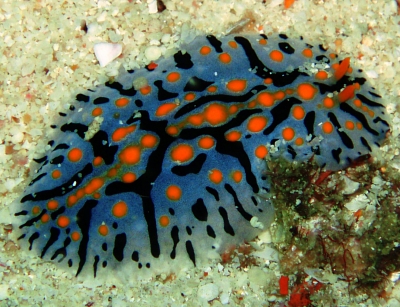
Dear Mike,
You are right to be cautious, some flatworms do look very like nudibranchs, but I have looked carefully at your original photos and I am pretty sure the rhinophores are real. I can see no sign of an anal papilla in the posterior dorsal midline so I suspect your animal is a colour form of the phyllidiid, Fryeria marindica .
Best wishes,
Bill Rudman
Fryeria marindica from Cocos (Keeling) Islands
September 17, 2005
From: Karen Willshaw

I found this nudibranch in approximate 11 metres of water in a fairly rubbly area of the Cocos (Keeling) Islands. Although I have searched through my Nudibranch books I cannot find anything definite to identify it. would appreciate your input, please.
Locality: Cocos (Keeling) Islands, Indian Ocean Australian Territory, Indian Ocean. Depth: 11 metres. Length: 5 cm. 29th August, 2005. rubble & sand.
Photographer: Karen Willshaw
Kind regards
Karen
karen@cocos-solutions.com
Willshaw, K., 2005 (Sep 17) Fryeria marindica from Cocos (Keeling) Islands. [Message in] Sea Slug Forum. Australian Museum, Sydney. Available from http://www.seaslugforum.net/find/14668Dear Karen,
From the colour pattern I am pretty sure this is Fryeria marindica. I obviously can't see the position of the anus, which in Fryeria is under the mantle, but the way the central row of tubercles has merged into a ridge suggests that species
Best wishes,
Bill Rudman
Fryeria marindica from Myanmar
April 7, 2003
From: Mary Jane Adams
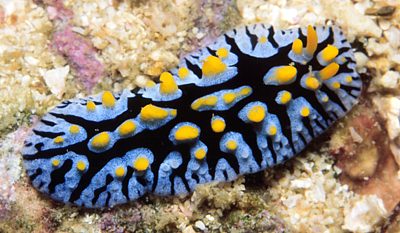
Hi Bill,
My best guess for this one is Fryeria marindica. What do you think? It was about 4 cm long and about 15 meters deep. Lei Ywei Lay Lon Island, Mergui Archipelago, Burma (Myanmar), Andaman Sea, 17 Feb, 2003.
Best regards,
Mary Jane
divepng@yahoo.com
Adams, M.J., 2003 (Apr 7) Fryeria marindica from Myanmar. [Message in] Sea Slug Forum. Australian Museum, Sydney. Available from http://www.seaslugforum.net/find/9519Thanks Mary Jane,
I agree that this is Fryeria marindica
Best wishes,
Bill Rudman
Fryeria marindica from Indian Ocean [1]
November 6, 2002
From: Marina Poddubetskaia
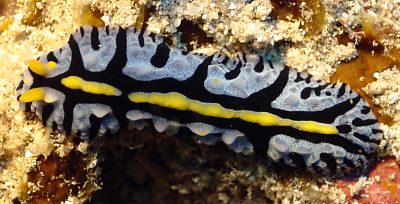
Dear Bill,
Here are some photos of what I think is Fryeria marindica. This species is quite common in both Reunion Island and Mauritius. Could you confirm this ID, please.
Upper: October 10, 2002
Location: St-Leu, Reunion Island, Indian Ocean. Site: Les arches, Depth: 14m
Size: 40-45mm
Lower Left & Right: October 07, 2002
Location : St-Leu, Reunion Island, Indian Ocean. Site: Le platier de la Pointe au Sel
Depth: 21m., Size: 50-55mm
Photos: Marina Poddubetskaia - Nembro website
Best wishes,
Marina.
nembro@nembro.info
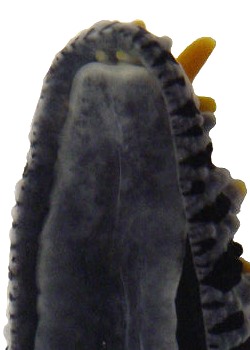
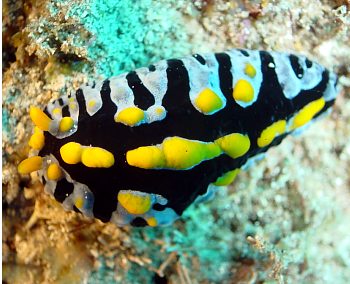
Dear Marina,
Thanks for these records of Fryeria marindica. Combined with the photos in your second message they show an interesting progression from animals in which the median dorsal ridge, which is usually bluish grey with yellow capped tuberles, is becoming a solid yellow ridge.
Best wishes,
Bill Rudman
Fryeria marindica from Indian Ocean [2]
November 6, 2002
From: Marina Poddubetskaia

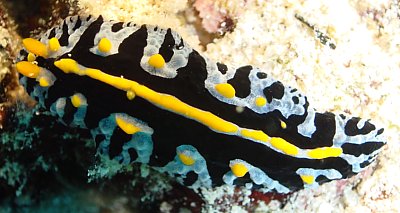
Dear Bill,
Here are two more photos of Fryeria marindica to accompany my earlier message.
Upper: October 15, 2002
Location: Pereybere, Mauritius, Indian Ocean
Site: L’aquarium de Merville, Depth: 10m., Size: 40-45mm
Lower: October 16, 2002
Location: Pereybere, Mauritius, Indian Ocean
Site: Grand Aquarium. Depth: 9m. Size: 35-40mm
Photos: Marina Poddubetskaia - Nembro website.
Best wishes,
Marina Poddubetskaia
nembro@nembro.info
Poddubetskaia, M., 2002 (Nov 6) Fryeria marindica from Indian Ocean [2]. [Message in] Sea Slug Forum. Australian Museum, Sydney. Available from http://www.seaslugforum.net/find/8337Thanks Marina,
Bill Rudman
Fryeria marindica sp. from Christmas Island
May 14, 2002
From: W.B. Rudman


Here is two records of Fryeria marinidica from John Hicks' Christmas Island, Indian Ocean collections.
PHOTOS:
• UPPER: AM C126508, 15 November 1980, Christmas Is., Indian Ocean. These two specimens were 21 – 22 mm long when alive.
• LOWER: AM C126506, 14 November 1980, off boat ramp, 20 ft, 46 mm long alive.
Christmas Is., Indian Ocean.
Photos: John Hicks
Best wishes,
Bill Rudman
Phyllidia babai? from Thailand
February 17, 2001
From: Erwin Koehler
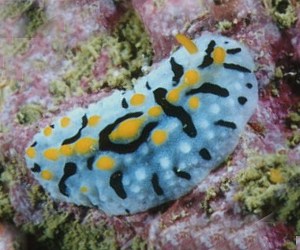
Dear Bill,
Here is the next one from Thailand, divesite "Anemone Reef", depth 22m, size 22mm, Dec. 19, 2000.
I think some time ago I saw a similar looking
one identified as Phyllidia babai, but I can't find it again.
Erwin
Medslugs.Koehler@t-online.de
Koehler, E., 2001 (Feb 17) Phyllidia babai? from Thailand. [Message in] Sea Slug Forum. Australian Museum, Sydney. Available from http://www.seaslugforum.net/find/3678Dear Erwin,
I can't be sure without some more information on the foot and the anatomy, but I am pretty sure that this is Fryeria marindica. Your animal is a bit paler than normal but the pattern is almost identical to one of the photos at the top of this page.
Best wishes,
Bill Rudman
Fryeria marindica from Japan?
October 28, 2000
From: Atsushi Ono
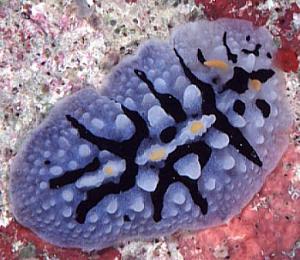
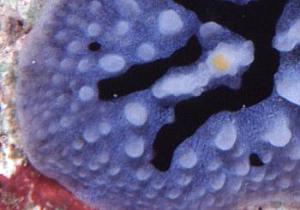
Dear Bill,
Thank you for a comment on Phyllidia exquisita.
I have attached an animal that is a similar to Fryeria marindica. But F. marindica is supposed to be an Indian Ocean species.
This animal was 30mm in length, found at 25m depth, at Kerama Is. in Japan.
I cannot find an anus on its back. Is this P. menindie or P. marindica?
Sincerely,
Atsushi Ono
ononini@cosmos.ne.jp
Ono, A., 2000 (Oct 28) Fryeria marindica from Japan?. [Message in] Sea Slug Forum. Australian Museum, Sydney. Available from http://www.seaslugforum.net/find/3250Dear Atsushi,
It certainly looks like F. marindica. I suspect we still have a lot to learn about the phyllidiids. Perhaps your find is indicating that F. marindica is not restricted to the Indian Ocean. At this stage I think it is best to call it Fryeria cf. marindica to indicate there is a slight doubt. It certainly does not fit the 'Pacific' species as defined by Brunckhorst.
You will notice I quite often use 'cf' when I am not sure of a name. It is an abbreviation for a Latin word meaning 'refer to' or 'close to' and is a nice way to signal we have a problem with an identification.
Best wishes,
Bill Rudman.
Fryeria marindica from Thailand
April 28, 2000
From: Narongpon Sittithaweepat
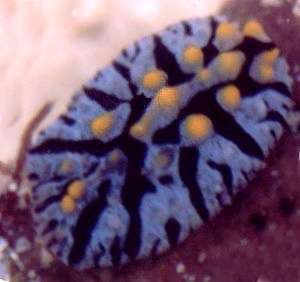
Dear Bill
I am not sure whether this specimen is Fryeria rueppelii . I found it in 50-60 feet at Surin Island. Its size is 3 cm. So could you please identify it for me.
Thank you for your kindness again
Narongpon
chromodorid@thaimail.com
Sittithaweepat, N., 2000 (Apr 28) Fryeria marindica from Thailand. [Message in] Sea Slug Forum. Australian Museum, Sydney. Available from http://www.seaslugforum.net/find/2324Dear Narongpon,
Your animal is a Fryeria, but according to Brunckhorst's review, F. rueppelii is found only in the Red Sea. Your animal is Fryeria marindica which has a widespread distribution throughout the Indian Ocean.
best wishes,
Bill Rudman.
Fryeria marindica? from South Africa
March 22, 2000
From: Valda Fraser
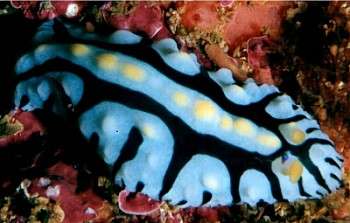
Dear Bill
Please identify the following nudibranch. Thank you.
Locality: South Coast KwaZulu-Natal, SOUTH AFRICA. Park Rynie - 25m
Date: February 2000
Size: 35mm
Regards
Valda Fraser
iti04937@mweb.co.za
Fraser, V., 2000 (Mar 22) Fryeria marindica? from South Africa. [Message in] Sea Slug Forum. Australian Museum, Sydney. Available from http://www.seaslugforum.net/find/2117Dear Valda,
This is another colour form of Fryeria marindica.
Best wishes,
Bill Rudman.
Fryeria marindica from South Africa
March 13, 2000
From: Valda Fraser
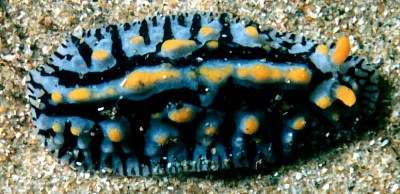
Dear Bill
This photo is awful, but hopefully you will still have "words of wisdom". I have quite a few black/white/yellow nudibranchs which are vaguely similar. I don't know whether they are variations or separate species. I've decided to start by sending this photo. I look forward to getting some feedback.
Locality: South Coast KwaZulu-Natal, SOUTH AFRICA. Shelly Beach (near Port Shepstone), 32m
Date: 5 March 2000
Size: 26mm
Regards
Valda Fraser
iti04937@mweb.co.za
Fraser, V., 2000 (Mar 13) Fryeria marindica from South Africa. [Message in] Sea Slug Forum. Australian Museum, Sydney. Available from http://www.seaslugforum.net/find/2054Dear Valda,
This is Fryeria marinidica. It is the only one of these blue and yellow species which has a distinctive median ridge or row of tubercles.
Best wishes,
Bill Rudman.
Fryeria marindica from Mauritius
February 3, 2000
From: Owen Griffiths

Dear Bill,
Can you identify this nudibranch from Mauritius please?
It was found at Riambel, Mauritius, in coral Lagoon, September 1999.
Owen Griffiths.
Mauritius
Olgmas@bow.intnet.mu
Griffiths, O.L., 2000 (Feb 3) Fryeria marindica from Mauritius. [Message in] Sea Slug Forum. Australian Museum, Sydney. Available from http://www.seaslugforum.net/find/1819Dear Owen,
This is the phyllidiid Fryeria marindica. It is endemic to the Indian Ocean. It is quite similar in shape and colour to Phyllidia varicosa. I discuss the differences at the Top of this Page.
Best wishes,
Bill Rudman.
Fryeria marindica from Mauritius
July 16, 1999
From: Erwin Koehler

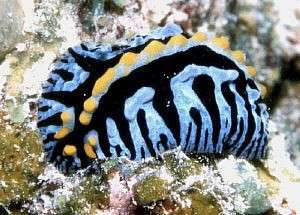
Bill,
Attached are 2 photos by Fred Vogt, Hamburg, Germany - made in Mauritius, April 1999, depth 18 m, size about 5 cm.
Can you identify it?
Erwin
Medslugs.Koehler@t-online.de
Koehler, E., 1999 (Jul 16) Fryeria marindica from Mauritius. [Message in] Sea Slug Forum. Australian Museum, Sydney. Available from http://www.seaslugforum.net/find/1075Dear Erwin,
This is Fryeria marindica. It is one of a number of species of Fryeria and Phyllidia which are quite confusing to separate. To help your sort them out I have posted pictures of all the species of Fryeria recognised by Brunckhorst. If you look at the discussions and comparisons on those pages it should be a bit clearer.
Unfortunately the main difference between species of
Best wishes,
Bill Rudman.
Five species of Fryeria added
July 16, 1999
From: Bill Rudman
To accompany Erwin Koehler's message about Fryeria marindica I have added all th known species of Fryeria from Brunckhorst's monograph (1993). the siz=x species are:
Bill Rudman.
